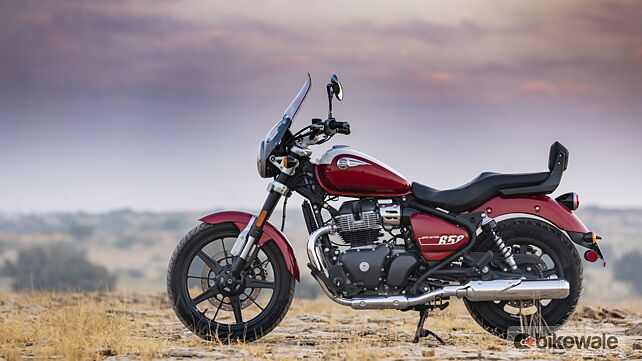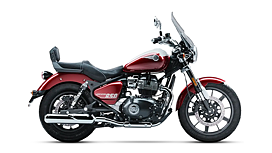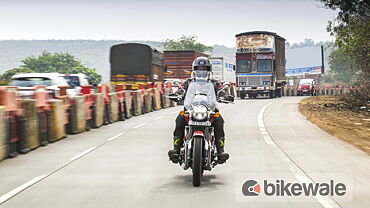Introduction
Why buy it?
- Great road presence
- Authentic cruiser vibes
- Lovely engine
Why avoid it?
- Busy ride quality
- Heavy kerb weight

We have already written lots about the Royal Enfield Super Meteor 650 from stories detailing its specifications, features, trim levels and colours. The only thing that remained was the riding experience, which we intend to rectify with this piece. But let us begin with visual cues.
The Visuals

The Super Meteor kills it with its styling and stance. The motorcycle looks bigger than the Interceptor. Plus, it looks nicer and more emotive in the flesh than it does in pictures or videos. The visual bulk is courtesy of the large tank, the fat rear fender, the enlarged fuel injection covers, and the wide and tall rear 16-inch wheel and tyre combo.

The desirability comes from its typical cruiser design elements like the raked-out front, the low scooped seat, and the horizontal tailpipes. Furthermore, in this top-spec Celestial trim, the windscreen, the taller and pulled-back handlebar, and the two-tone paint finish for the fuel tank work towards enhancing the Super Meteor’s visual appeal.

The detailing on the motorcycle is good too. The badge is a chunky and solid-looking interpretation of the traditional RE logo. The dark matte finish on the engine's cases and valve cover work beautifully in contrast with the chrome exhaust. There are satin chrome highlights all around, from the switch cubes to the fork tees to the headlight hangers. These exude a sense of effort and richness that owners are bound to appreciate every time they look at their bikes.
The Package

The Super Meteor borrows its engine from the Interceptor and the Continental GT 650. Even though Royal Enfield has changed the intake and exhaust on the new bike, the output figures of 47bhp of max power and 52Nm of peak torque remain unchanged. The six-speed gearbox continues unchanged as well.

The chassis and suspension are new, though. The former has been redesigned to suit the cruiser stance better, while the upside-down front forks and the rear coil-over units offer more travel now compared to the INT and GT. A happy byproduct of this change is a very accessible seat height of 740mm, which is significantly lower than even the Interceptor.
Additionally, the Super Meteor runs a larger rear disc brake in line with cruiser essentials. The wheels - 19-inch at the front and 16-inch at the rear - are now alloys shod with tubeless tyres. It also features an all-LED headlamp, adjustable levers for the clutch and the front brake, the tripper navigation unit, and dual-channel ABS.

When seated, the riding triangle of the Super Meteor is again quintessentially cruiser-like with forward-set footpegs and a wide handlebar that comes to the rider instead of the latter having to reach for it. This is more pronounced in the Celestial version thanks to the handlebar riser that moves the handle even closer to the rider. There’s also nothing to foul with the rider’s leg when pedaling through traffic or pushing the bike around in a parking lot. This is down to the forward-placed rider’s footpegs and an exhaust routing that's nicely tucked under the engine.
The Ride
However, the real fun begins when you press the motor into business. The 650 twin has always been a joy to engage with on the road, and it is no different on the Super Meteor.

It has good low and mid-range torque that makes the motorcycle feel lighter than it is. Plus, one can comfortably short shift and rely on the engine’s meaty torque to handle everything from overtakes to changes in cruising speed. Thinking and planning to stay in the optimal power-band isn’t something that plagues a 650 rider, which for a cruiser is fantastic. Every time you open the throttle, it picks up its skirt and gets going, no matter the rpm.

It is also still a smooth and near vibe-free engine. And it can sit at three-digit speeds all day without a hint of bother. It also gets there without delay, with a sonorous intake and a soothing exhaust note accompanying the acceleration. Sitting at 100kmph or 120kmph comes easy to the Super Meteor. But, roads that allow the latter are few and far in between.
If anything, we would have liked the gearshift quality to be a little slicker. It is possibly down to the extended gearshift linkage as part of the revised placement of the footpegs. But, given our experiences with the INT and GT, we expected the Meteor 650 to deliver the same level of crispness.

The handling of the Super Meteor did pleasantly surprise us, however. Now, it is not as involving or fun to ride as the Interceptor or the GT, but, it is no slouch either. Sure, it takes a little more effort to get the motorcycle to change directions courtesy of the lazier rake angle and the bigger front wheel compared to its other 650cc siblings. But, once it begins leaning into a bend, it does so in a flowing and linear manner. Moreover, after a few corners, your mind and responses adjust to the larger Meteor's mildly slower but the sure-footed dance of changing directions. And then, it begins to feel quite delightful.

The longer rake and the bigger front wheel do have their advantages. It gives the motorcycle a more planted feel in a straight line at speed, which is confidence-inspiring. As a result, the Super Meteor feels completely at home when riding across Rajasthan. And, it should be the same when doing a Mumbai-Delhi run or travelling from the west coast to the east coast of India via Solapur and Hyderabad.
The ride quality, however, could be better. It feels fine on a well-paved road. But even the slightest patchwork on the road begins to show the chinks in the Super Meteor’s comfort armour.

The front upside forks work well. These absorb the patch works and even bumps and potholes with a sense of plushness. But, the rear feels unsettled on anything but the smoothest of roads. The ride feels busy over mildly broken roads but hit a big pothole or bump, and the rear twin shock setup shocks your back quite uncomfortably. It is not something one enjoys with foot-forward seating.
Should you buy it?

The Super Meteor 650 is a lovely motorcycle. But given that the 650cc twin was its starting point, it was always going to be endearing. The fact that it is in a class of its own also gives it a big advantage. Yes, you have the Kawasaki Vulcan S; also a 650cc, twin-cylinder feet-forward cruiser. But, it is near twice the price.
The competition then - in a sense - comes from within the family; namely the Interceptor 650. But, apart from the powertrain, the two bikes are vastly different.

The Super Meteor, for instance, is the better motorcycle for long-distance riding. Its tailpipe design allows for easy mounting of the luggage. Its longer, plusher seat and more comfortable seating triangle for the pillion make it the better two-seater. And, with its raked-out front, lazy seating and a cushier rider’s seat, it is also nicer of the two to spend long hours on.
And even though it is Rs 80,000 more expensive than the Interceptor 650, it justifies this premium with handy add-ons.

The bigger Meteor gets alloy wheels, USD front forks, a bigger rear brake disc, more up-to-date instrumentation, LED lights, and adjustable levers, which are missing on the INT650. So, if you see the Interceptor as good value, then the Super Meteor with the extras, even with a higher price tag, should naturally seem the same.
Photography: Kapil Angane
Gallery
1/143
Royal Enfield Super Meteor 650 Left Side View
Double Tap to Zoom













































